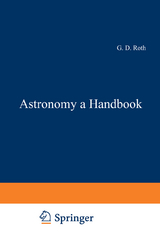Astronomy: a Handbook
Springer Berlin (Verlag)
978-3-642-48284-7 (ISBN)
1 / Introduction to Astronomical Literature and Nomenclature.- 1.1 The Universe and the Amateur Astronomer.- 1.2 Astronomical Literature.- 1.3 Charts and Catalogs.- 1.4 Almanacs.- 1.5 Reduction of Observations.- 2 / The Observing Instruments of the Amateur Astronomer.- 2.1 The Performance of Astronomical Observing Instruments.- 2.2 The Components of Astronomical Observing Instruments.- 3 / Optical Radiation Receivers.- 3.1 Introduction.- 3.2 The Human Eye.- 3.3 The Photographic Emulsion.- 3.4 The Photoelectric Cell.- 3.5 Television Technique.- 4 / Radio Astronomy for Amateur Astronomers.- 4.1 Introduction.- 4.2 Fundamentals of Radio Astronomy.- 4.3 The Instruments.- 4.4 The Radio-Astronomical Objects.- 4.5 The Instrumental Possibilities of the Amateur Astronomer.- 5 / The Terrestrial Atmosphere and Its Effects.- 5.1 General Remarks Concerning the Earth's Atmosphere.- 5.2 Weather-Dependant Phenomena.- 5.3 Permanent Atmospheric Phenomena.- 6 / Fundamentals of Spherical Astronomy.- 6.1 Introduction.- 6.2 The Coordinates.- 6.3 The Time and the Phenomena of Daily Motion.- 6.4 Changes in the Coordinates of a Star.- 6.5 Calendars, Years, Julian Dates, and Normal Times.- 6.6 Variability of the Rotation of the Earth, Ephemeris Time and the Definition of the Second.- 6.7 Spherical Trigonometry.- 7 / Modern Sundials.- 7.1 Introduction.- 7.2 The Equinoxial Sundial.- 7.3 Design of a Horizontal Dial and of a Vertical East-West Dial.- 7.4 The Construction of a Horizontal and a Vertical East-West Dial.- 7.5 The Vertical Declining Dial.- 8 / Applied Mathematics for Amateur Astronomers.- 8.1 Introduction.- 8.2 Theory of Errors.- 8.3 Interpolation and Numerical Differentiation and Integration.- 8.4 Photographic Astrometry.- 8.5 Determination of the Position and Brightness of Planets andof the Planetographic Coordinates.- 8.6 The Reduction of Star Occultations.- 9 / The Sun.- 9.1 Introduction.- 9.2 Observation of the Sun.- 9.3 Phenomena on the Sun's Disc.- 9.4 Determination of Positions of Solar Phenomena.- 9.5 Photography of the Sun.- 9.6 Conclusions.- 10 / Observation of Total Solar Eclipses.- 10.1 Photography of the Solar Corona.- 10.2 Special Astronomical Programs.- 10.3 Special Terrestrial Programs.- 10.4 The Observing Station.- 11 / The Moon.- 11.1 Problems and Ideas of Lunar Observations.- 11.2 Conditions of Visibility.- 11.3 The Lunar Formations.- 11.4 Optical Observations.- 11.5 The Grid of Lunar Maps.- 12 / Lunar Eclipses.- 12.1 Introduction.- 12.2 Prediction of Lunar Eclipses.- 12.3 Enlargement of the Earth's Shadow.- 12.4 Photometry of Lunar Eclipses.- 12.5 Photography of Lunar Eclipses.- 13 / The Observation of Star Occultations.- 13.1 General Remarks.- 13.2 Predictions.- 13.3 Optical Requirements.- 13.4 Time Measurement.- 13.5 Evaluation of the Observational Results.- 13.6 Occultations of the Planets.- 14 / Artificial Earth Satellites.- 14.1 Nature and Purpose of the Satellites.- 14.2 Conditions of Visibility.- 14.3 Optical Observations.- 14.4 Time Services.- 14.5 Radio Observations.- 14.6 Elementary Calculation of the Orbit.- 14.7 Elliptical Orbits.- 15 / The Observation of the Planets.- 15.1 The Observation of Planetary Surfaces.- 15.2 The Observation of the Various Planets.- 15.3 Star Occultations by Planets.- 15.4 The Photography of Planetary Surfaces.- 15.5 Micrometer Measurements and Photometry of the Planetary Surfaces.- 16 / The Observation of Comets.- 16.1 Introductory Remarks.- 16.2 Visual Observations.- 16.3 Visual Determination of Position.- 16.4 Photographic Determination of Position.- 16.5 Observations of CometaryStructure.- 16.6 Photometry.- 16.7 Spectrum and Polarization.- 17 / Meteors and Fireballs.- 17.1 General Notes About Meteors.- 17.2 Methods of Observation.- 17.3 Special Observational Problems.- 17.4 Determination of Meteor Orbits.- 18 / Noctilucent Clouds, Aurorae, Zodiacal Light.- 18.1 Introduction.- 18.2 The Zodiacal Light.- 18.3 Observation of Aurorae.- 18.4 Noctilucent Clouds.- 18.5 Luminous Bands.- 18.6 The Blue Sun.- 19 / The Photometry of Stars and Planets.- 19.1 On the Measurement of the Sensitivity of the Eye.- 19.2 The Photometric Capabilities of the Eye.- 19.3 Sources of Error in the Estimation and Measurement of Brightness.- 19.4 The Preparation of a Brightness Estimate.- 19.5 Brightness Estimates.- 19.6 Brightness Measurements.- 19.7 The Reduction of Photometric Observations of Variable Stars.- 19.8 On the Photometry of the Major Planets.- 19.9 On the Photometry of the Minor Planets.- 19.10 Notes on the Measurement of Colors.- 20 / Double Stars.- 20.1 The Visual Double Stars.- 20.2 Micrometers and Visual Measurements.- 20.3 Photographic Observations.- 20.4 Orbital Elements and Ephemerides.- 21 / The Milky Way and the Galaxies.- 21.1 Introduction.- 21.2 The Instruments.- 21.3 The Most Important Objects.- 22 / Appendix.- 23 / Bibliography.
| Erscheint lt. Verlag | 1.7.2012 |
|---|---|
| Reihe/Serie | Astronomy: a Handbook |
| Übersetzer | A. Beer |
| Zusatzinfo | XVIII, 568 p. |
| Verlagsort | Berlin |
| Sprache | englisch |
| Maße | 155 x 235 mm |
| Gewicht | 878 g |
| Themenwelt | Naturwissenschaften ► Physik / Astronomie ► Allgemeines / Lexika |
| Naturwissenschaften ► Physik / Astronomie ► Astronomie / Astrophysik | |
| Schlagworte | Astronomie • Astronomy • Fields • Mechanics • Optics • telescope |
| ISBN-10 | 3-642-48284-8 / 3642482848 |
| ISBN-13 | 978-3-642-48284-7 / 9783642482847 |
| Zustand | Neuware |
| Informationen gemäß Produktsicherheitsverordnung (GPSR) | |
| Haben Sie eine Frage zum Produkt? |
aus dem Bereich




